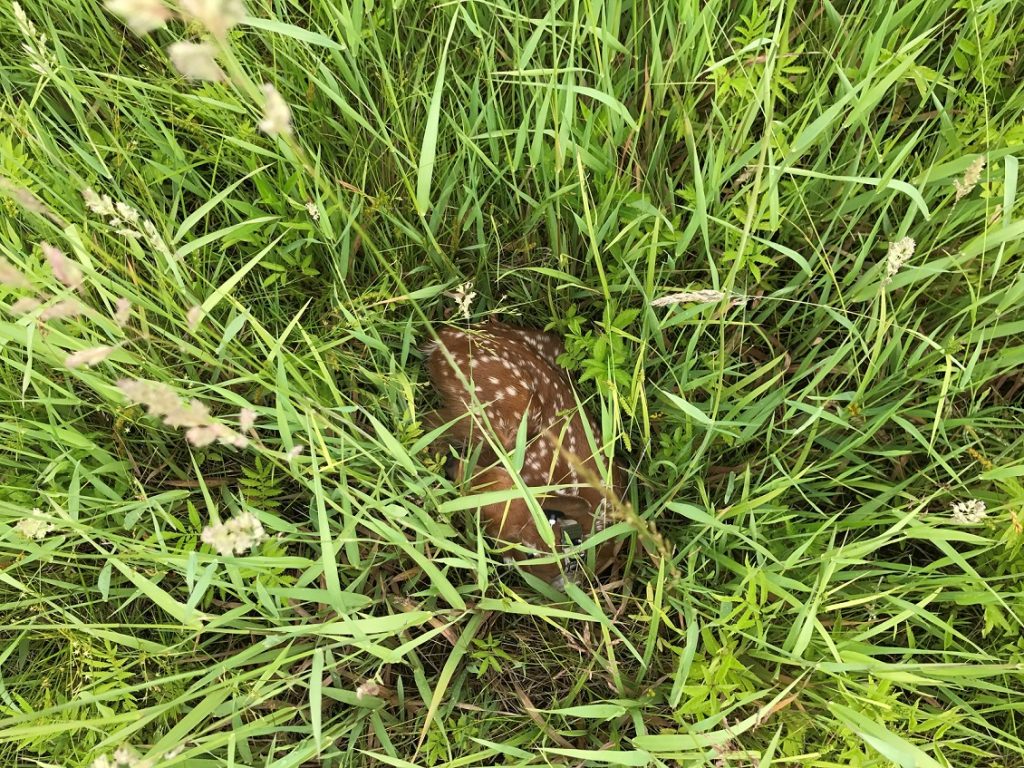Over a year ago the self-proclaimed “Crazy Cat Lady” Jeannine and I wrote a blog post about Mr. Buttons-sized GPS units. We aren’t interested in tracking Mr. Buttons [Buttons tracking should not be necessary as feline companions should remain indoors]. But we are interested in tracking fawns.
Most of our understanding of how large herbivores use and move through their habitats centers on adult bucks and does. However, we know that fawns are the most vulnerable deer on the landscape.
Researchers are interested in fawn movement and home ranges for a lot of reasons. For example, one study looked at whether fawns with more forest in the home range meant they were more or less vulnerable to coyote predation (Spoiler Alert: more forest edge in a fawn’s home range results in less vulnerable fawns).
There are ways to track cute fawns in the woods. We need to know if they are alive or not for all those fawn survival studies. Let’s walk through the current way researchers have attempted to study fawn movement and home ranges.
Captured fawns are adorned with a cute, tiny collar. These tiny collars are designed to expand with the fawn as it grows. Unfortunately, these collars don’t have GPS capabilities.
So how do we find the fawns? These collars are VHF sending out a very high frequency radio signal (aka a bunch of beeps). The signals from the collar don’t travel very far and don’t take a lot of battery power. But that means a person has to go out, get close enough to the collar to hear that signal, and pinpoint a location. [Non-GPS trackers are considered “old school” by anyone under 35 years old. Back when Jeannine was a graduate student, it was VHF or nothing!]
These limitations mean we don’t get very many positions and the positions we do record may not be as accurate as GPS collars.
Cue our Crazy Cat Lady Research.
A paper published in 2015 put these little GPS units on some tiny dogs and then walked them around to test their accuracy. They looked at how well the units did in comparison to more expensive and established GPS units. They found that these collars performed as well as other, more expensive GPS collars used in wildlife research! 
So we decided to give it a go and deployed 50 of these micro-GPS units on fawns in 2016 and 2017 to see how well these units performed in the field and if the results are comparable to the current estimates of fawn home range and movements.
These micro-GPS units aren’t perfect. Of the 50 GPS units we put out on fawns, we only got back 29. Part of the reason those larger GPS collars for adults are so expensive is because they are easier to retrieve. A couple of mouse clicks on a computer and the big adult collars will drop off. Then send in the field crew and the collar magically ends up on my desk with all the data!
But these micro-GPS collars don’t have that magic. To get them back, the collar needs to fall off the deer which these collars are designed to do as the fawns age.
There was another issue too. Of the 29 units I got back, only 20 turned back on so I could download the data. Sigh…maybe there was water damage but ultimately who knows.
On the bright side, we had 20 fawns tracked with GPS – the first ones ever! Pretty exciting!
I’ve been diving into these data looking at home range size and how much fawns move. How do these compare with traditional fawn tracking? We’ll soon see.
Department of Ecosystem Science and Management
If you would like to receive email alerts of new blog posts, subscribe here.
And Follow us on Twitter @WTDresearch
